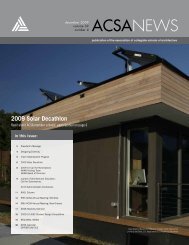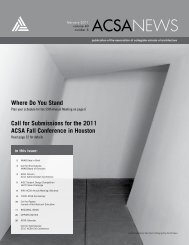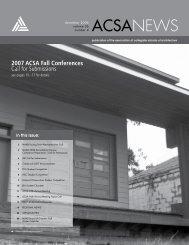digital aptitudes - Association of Collegiate Schools of Architecture
digital aptitudes - Association of Collegiate Schools of Architecture
digital aptitudes - Association of Collegiate Schools of Architecture
You also want an ePaper? Increase the reach of your titles
YUMPU automatically turns print PDFs into web optimized ePapers that Google loves.
SATURDAY, MARCH 3, 2012 - 2:00PM - 3:30PM<br />
Post-Parametric Environments<br />
Jennifer Leung, Yale University<br />
Biochemical Injections - <strong>Architecture</strong> as a Biotechnical<br />
Interface in a Post-parametric Environment.<br />
Mina Yaney<br />
Biochemical Injections is examining the potential <strong>of</strong> a creative, heterogeneous<br />
and perpetually variable interface between architecture,<br />
bio-technologies, postmodern philosophy as well as political<br />
theory. The intersecting point between these four fields is identified<br />
as the organic body, taken to mean all kinds <strong>of</strong> different bodies,<br />
be they biological, chemical, physical or geological. What all<br />
embodied entities share, is that one can clearly conceive <strong>of</strong> them as<br />
an irreducible, corporeal, informational field which displays the relation<br />
and performs the negotiation between different forces. This<br />
difference <strong>of</strong> forces can be variably re-modulated and interfaced<br />
through different biotechnologies. Since biotechnological practice<br />
is circling around harnessing, manipulating and managing the<br />
manufacturing, differentiating, propagating and fusing capacities<br />
<strong>of</strong> tissues, cells, proteins and molecules, the notion <strong>of</strong> the organic<br />
body is, hence, rendered as intrinsically open for re-modulation.<br />
The biotechnological re-modulatability <strong>of</strong> the organic body opens<br />
up a vast ethico-aesthetical paradigm on a molecular level and<br />
clearly implies a re-modulation <strong>of</strong> the political, philosophical and<br />
architectural as well. Hence, architectural design can be rethought<br />
as inducing organic form from within - through modulation - rather<br />
than mechanically imposing form from the outside. Can we specify<br />
architectural approaches in which biotechnics may amplify, augment,<br />
recombine and interface different life forces, forms <strong>of</strong> vitality,<br />
and transformative productivity, governing the emergence <strong>of</strong><br />
environmental bodies <strong>of</strong> habitation?<br />
Communication Theory as an Anti-environment for<br />
Understanding the Effects <strong>of</strong> Technological Environments<br />
upon Cultural Change<br />
Isaac Lerner, Eastern Mediterranean University<br />
Abstract: In order to deal with the bias <strong>of</strong> the ‘environment’ shaping<br />
cultural and social prejudices in architecture and urbanism in<br />
the information age, Marshall McLuhan’s communication theory<br />
<strong>of</strong> cultural change provides a meaningful analysis <strong>of</strong> the effects <strong>of</strong><br />
technological environments, as a means <strong>of</strong> heightened perception.<br />
In the current age, where the <strong>digital</strong> infrastructural environment<br />
<strong>of</strong> cyberspace envelopes and transforms all pre-existing cultural<br />
and natural habitats, the scale and pace <strong>of</strong> this transformation and<br />
its psychological, sociological as well as material effects escapes<br />
perception. McLuhan’s prose-poetic style and his mosaic form <strong>of</strong><br />
discourse satirize, or as he says “puts-on”, the reader in order to attune<br />
perception so that understanding media effects is facilitated.<br />
The interplay <strong>of</strong> cultures and the possibility for global cooperation<br />
depends on harmonizing spatial biases as determined by the media<br />
ecology (i.e. operational technological environments) and its effects<br />
on group behavior. In terms <strong>of</strong> modern evolutionary theory,<br />
such as the work <strong>of</strong> evolutionist David Sloan Wilson, at the group<br />
level, altruistic or cooperative traits versus competitive or selfish<br />
traits are selected for which sustains the survival <strong>of</strong> the group. In<br />
this way, evolution occurs if there is another layer to the process<br />
<strong>of</strong> natural selection which is the layer <strong>of</strong> group selection. This is the<br />
layer, in terms <strong>of</strong> McLuhan’s work, whereby, by shaping our tools<br />
we shape ourselves as a culture. By complementing modern evolutionary<br />
group theory with McLuhan’s communication theory <strong>of</strong><br />
cultural change this enhances insight, and consequently provides<br />
a means <strong>of</strong> anticipatory design, for architects and urban planners.<br />
Risky Business: From Digital Fabrication to the Abstract<br />
Workshop<br />
Mark Cabrinha, California Polytechnic State University<br />
The legal boundary separating architects’ conception from execution<br />
is broached through a new genre <strong>of</strong> workshop practices enabled<br />
by <strong>digital</strong> fabrication. The challenges and opportunities <strong>of</strong><br />
these workshop practices and their reflection on contemporary design<br />
culture are made visible through a series <strong>of</strong> interviews I conducted<br />
between 2005 and 2008. These interviews help to position<br />
the pedagogical place <strong>of</strong> <strong>digital</strong> fabrication not as argument for the<br />
design-build process, but rather in the formation <strong>of</strong> the image <strong>of</strong><br />
practice as an abstract workshop enabled through parametric design<br />
tools. Abstractions develop from real world objects and experiences<br />
becoming generalized, as abstractions, to apply to multiple<br />
scenarios and situations, taking the general from the concrete. The<br />
concept <strong>of</strong> the abstract workshop is grounded by material systems<br />
but not fixed within one particular domain or application, and in so<br />
doing, can leverage scale in the way direct fabrication never could.<br />
The Parameters <strong>of</strong> the Posthuman<br />
Ariane Lourie Harrison, Yale University<br />
This paper recruits another “post”—the posthuman—to reflect on<br />
the slippery status <strong>of</strong> the “post-parametic” environment, marking<br />
our changing relationship to nature and registering what we term<br />
an emerging architectural imagination <strong>of</strong> posthuman hybridity.<br />
The posthuman interpretation <strong>of</strong> longstanding ecological concepts<br />
<strong>of</strong> “hybridity” and “assemblage” allows us to explore the heterogeneous<br />
urban environments produced in two realized works by<br />
R&Sie (n) and The Living. The paper proposes that these examples<br />
<strong>of</strong> contemporary architecture modify conventional understandings<br />
<strong>of</strong> subject/object relations and instead address the posthuman “hybrid<br />
subject”. Featuring animal subjects and vegetal cyborgs, these<br />
works visualize the presence <strong>of</strong> human and non-human subjects as<br />
assemblages which do not perform according to the “optimizing”<br />
filters <strong>of</strong> parameterized behavior. Instead, A posthuman approach<br />
to architecture expands the architectural subject beyond the human<br />
user, extends the architectural building material to include<br />
assemblages <strong>of</strong> inorganic and organic, and invokes the architectural<br />
assemblage as a multi-scale territory. The post-parametic (or<br />
posthuman) imagination suggests that what was formerly known<br />
as nature is an environment bristling with hybrid subjects.<br />
Digital Apptitutes + Other Openings - Boston, MA - 31








